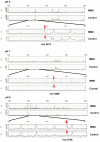Identification of novel biomarker candidates by proteomic analysis of cerebrospinal fluid from patients with moyamoya disease using SELDI-TOF-MS
- PMID: 21059247
- PMCID: PMC2992492
- DOI: 10.1186/1471-2377-10-112
Identification of novel biomarker candidates by proteomic analysis of cerebrospinal fluid from patients with moyamoya disease using SELDI-TOF-MS
Abstract
Background: Moyamoya disease (MMD) is an uncommon cerebrovascular condition with unknown etiology characterized by slowly progressive stenosis or occlusion of the bilateral internal carotid arteries associated with an abnormal vascular network. MMD is a major cause of stroke, specifically in the younger population. Diagnosis is based on only radiological features as no other clinical data are available. The purpose of this study was to identify novel biomarker candidate proteins differentially expressed in the cerebrospinal fluid (CSF) of patients with MMD using proteomic analysis.
Methods: For detection of biomarkers, CSF samples were obtained from 20 patients with MMD and 12 control patients. Mass spectral data were generated by surface-enhanced laser desorption/ionization time-of-flight mass spectrometry (SELDI-TOF-MS) with an anion exchange chip in three different buffer conditions. After expression difference mapping was undertaken using the obtained protein profiles, a comparative analysis was performed.
Results: A statistically significant number of proteins (34) were recognized as single biomarker candidate proteins which were differentially detected in the CSF of patients with MMD, compared to the control patients (p < 0.05). All peak intensity profiles of the biomarker candidates underwent classification and regression tree (CART) analysis to produce prediction models. Two important biomarkers could successfully classify the patients with MMD and control patients.
Conclusions: In this study, several novel biomarker candidate proteins differentially expressed in the CSF of patients with MMD were identified by a recently developed proteomic approach. This is a pilot study of CSF proteomics for MMD using SELDI technology. These biomarker candidates have the potential to shed light on the underlying pathogenesis of MMD.
Figures




Similar articles
-
Biomarker research for moyamoya disease in cerebrospinal fluid using surface-enhanced laser desorption/ionization time-of-flight mass spectrometry.J Stroke Cerebrovasc Dis. 2015 Jan;24(1):104-11. doi: 10.1016/j.jstrokecerebrovasdis.2014.07.028. Epub 2014 Oct 28. J Stroke Cerebrovasc Dis. 2015. PMID: 25440344
-
Elevation of CRABP-I in the cerebrospinal fluid of patients with Moyamoya disease.Stroke. 2003 Dec;34(12):2835-41. doi: 10.1161/01.STR.0000100159.43123.D7. Epub 2003 Nov 6. Stroke. 2003. PMID: 14605320
-
Downregulation of Apolipoprotein-E and Apolipoprotein-J in Moyamoya Disease-A Proteome Analysis of Cerebrospinal Fluid.J Stroke Cerebrovasc Dis. 2017 Dec;26(12):2981-2987. doi: 10.1016/j.jstrokecerebrovasdis.2017.07.028. Epub 2017 Aug 23. J Stroke Cerebrovasc Dis. 2017. PMID: 28843803
-
Advances in clinical cancer proteomics: SELDI-ToF-mass spectrometry and biomarker discovery.Brief Funct Genomic Proteomic. 2005 May;4(1):16-26. doi: 10.1093/bfgp/4.1.16. Brief Funct Genomic Proteomic. 2005. PMID: 15975261 Review.
-
SELDI-TOF serum proteomics and colorectal cancer: a current overview.Arch Physiol Biochem. 2010 Oct-Dec;116(4-5):188-96. doi: 10.3109/13813455.2010.495130. Epub 2010 Jul 8. Arch Physiol Biochem. 2010. PMID: 20615064 Review.
Cited by
-
Targeted metabolomics analysis of serum amino acid profiles in patients with Moyamoya disease.Amino Acids. 2022 Jan;54(1):137-146. doi: 10.1007/s00726-021-03100-w. Epub 2021 Nov 20. Amino Acids. 2022. PMID: 34800175
-
Genetic and Proteomic Contributions to the Pathophysiology of Moyamoya Angiopathy and Related Vascular Diseases.Appl Clin Genet. 2021 Mar 18;14:145-171. doi: 10.2147/TACG.S252736. eCollection 2021. Appl Clin Genet. 2021. PMID: 33776470 Free PMC article. Review.
-
Utilization of Cerebrospinal Fluid Proteome Analysis in the Diagnosis of Meningioma: A Systematic Review.Cureus. 2021 Dec 26;13(12):e20707. doi: 10.7759/cureus.20707. eCollection 2021 Dec. Cureus. 2021. PMID: 34966627 Free PMC article. Review.
-
Proteome Profiling of the Dura Mater in Patients with Moyamoya Angiopathy.Int J Mol Sci. 2023 Jul 7;24(13):11194. doi: 10.3390/ijms241311194. Int J Mol Sci. 2023. PMID: 37446373 Free PMC article.
-
Metabolomic Profiling Revealed Potential Biomarkers in Patients With Moyamoya Disease.Front Neurosci. 2020 Apr 21;14:308. doi: 10.3389/fnins.2020.00308. eCollection 2020. Front Neurosci. 2020. PMID: 32372905 Free PMC article.
References
-
- Suzuki J, Takaku A. Cerebrovascular "moyamoya" disease. Disease showing abnormal net-like vessels in base of brain. Arch Neurol. 1969;20:288–299. - PubMed
-
- Mineharu Y, Takenaka K, Yamakawa H, Inoue K, Ikeda H, Kikuta KI, Takagi Y, Nozaki K, Hashimoto N, Koizumi A. Inheritance pattern of familial moyamoya disease: autosomal dominant mode and genomic imprinting. J Neurol Neurosurg Psychiatry. 2006;77:1025–1029. doi: 10.1136/jnnp.2006.096040. - DOI - PMC - PubMed
MeSH terms
Substances
LinkOut - more resources
Full Text Sources

